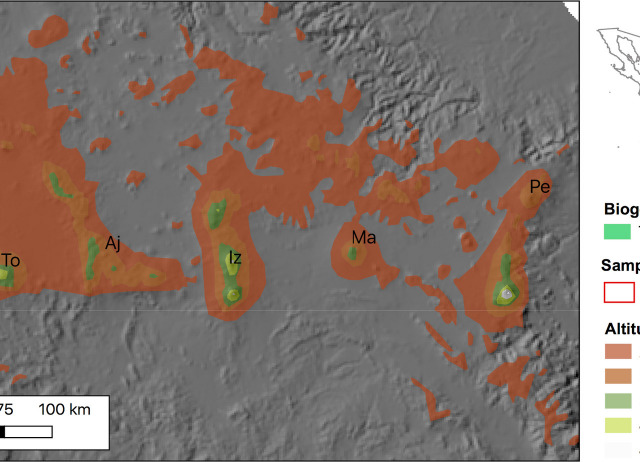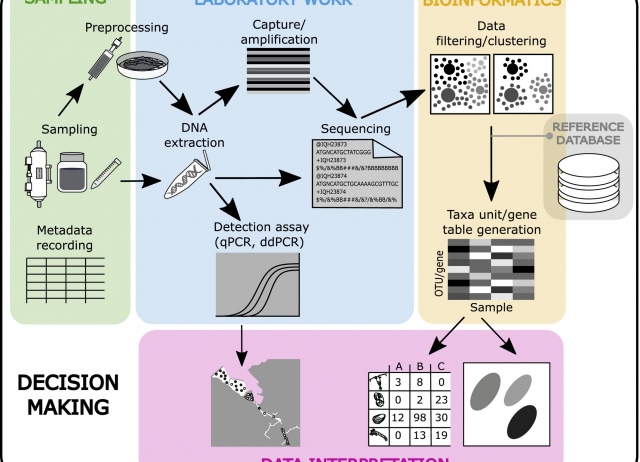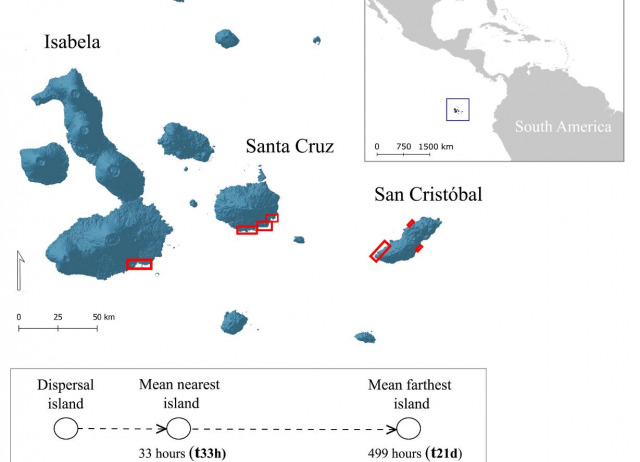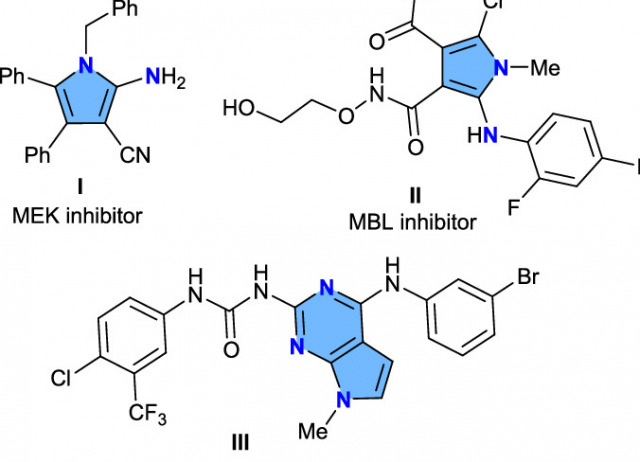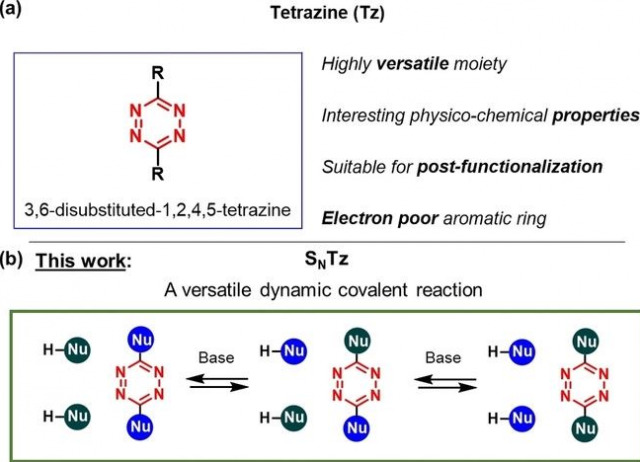
Dynamic Nucleophilic Aromatic Substitution of Tetrazines
A dynamic nucleophilic aromatic substitution of tetrazines (SNTz) is presented herein. It combines all the advantages of dynamic covalent chemistry with the versatility of the tetrazine moiety. Indeed, libraries of compounds or sophisticated molecular structures can be easily obtained, which are susceptible to post-functionalization by inverse electron demand Diels–Alder (IEDDA) reaction, which also locks the exchange. Additionally, the structures obtained can be disassembled upon the application of the right stimulus, either UV irradiation or a suitable chemical reagent. Moreover, SNTz is compatible with the imine chemistry of anilines. The high potential of this methodology has been proved by building two responsive supramolecular systems: A macrocycle that displays a light-induced release of acetylcholine; and a truncated [4+6] tetrahedral shape-persistent fluorescent cage, which is disassembled by thiols unless it is post-stabilized by IEDDA.
Santos, Tanausú; Rivero, David S.; Pérez-Pérez, Yaiza; Martín-Encinas, Endika; Pasán, Jorge; Hernández Daranas, Antonio; Carillo, Romen
Evaluating species origins within tropical sky-islands arthropod communities
Aim: To (a) evaluate if colonization of newly emerged high-elevation habitats occurred from neighbouring highlands (allopatric divergence and niche conservatism) or from within the same mountain (peripatric or parapatric divergence and niche shift), and (b) test for the effect of past landscape configurations in geographically structuring biodiversity (a West-East structure spanning the central part of the Transmexican Volcanic Belt).Location: Transmexican Volcanic Belt, Mexico. Taxa: Coleoptera and Araneae. Methods: Coleoptera and Araneae communities were collected in a comparative sampling framework. Seven sky-islands were sampled within two high-elevation habitats separated by altitude. Samples were individually sequenced for a region of the mtDNA COI gene to delimit Operational Taxonomic Units (OTUs) and haplotypes within them. Richness was estimated at the community level, as well as genetic diversity within and among mountains and habitats. The West East structure was tested with a null model and an analysis of variance with permutations. Results: Few OTUs were shared between the Abies forests and alpine grasslands. High beta diversity was found across mountains. Beta diversity between the West – East grouping is higher than expected by chance. Main conclusions: Our results indicate that colonization from other mountains followed by allopatric divergence dominates as a source of OTU formation, and that despite some probable connectivity during glacial periods existed, ancient communities and genetic structures persist.
Uscanga-Castillo, Adriana; López, Heriberto; Piñero, Daniel; Emerson, Brent C.; Mastretta-Yanes, Alicia
The Chemistry of Reactive Oxygen Species (ROS) Revisited: Outlining Their Role in Biological Macromolecules (DNA, Lipids and Proteins) and Induced Pathologies
Living species are continuously subjected to all extrinsic forms of reactive oxidants and others that are produced endogenously. There is extensive literature on the generation and effects of reactive oxygen species (ROS) in biological processes, both in terms of alteration and their role in cellular signaling and regulatory pathways. Cells produce ROS as a controlled physiological process, but increasing ROS becomes pathological and leads to oxidative stress and disease. The induction of oxidative stress is an imbalance between the production of radical species and the antioxidant defense systems, which can cause damage to cellular biomolecules, including lipids, proteins and DNA. Cellular and biochemical experiments have been complemented in various ways to explain the biological chemistry of ROS oxidants. However, it is often unclear how this translates into chemical reactions involving redox changes. This review addresses this question and includes a robust mechanistic explanation of the chemical reactions of ROS and oxidative stress.
Andrés Juan, Celia; Pérez de Lastra, José Manuel; Plou Gasca, Francisco José; Pérez-Lebeña, Euardo
Biodiversity monitoring using environmental DNA
Monitoring biodiversity is essential to protect, preserve and restore ecosystems, particularly in the context of current challenges such as climate change, habitat destruction and globalization (Baird & Hajibabaei, 2012). Biomonitoring is needed for developing biotic indices for assessing ecological status, measuring impacts of anthropogenic activities in natural ecosystems, evaluating biodiversity loss, surveying nonindigenous species, conservation, and identifying cryptic species (Balvanera et al., 2006; Fišer et al., 2018). Thus, spatially and temporally structured biomonitoring activities provide a powerful tool for the implementation of regional, national and international regulations, directives and policies for nature conservation. However substantial impediments exist including access to remote locations, limited specialist taxonomic knowledge, cost, slow pace of human-driven data analyses, and typically low sensitivity for detection of rare and elusive species (Zinger et al., 2020). These drawbacks are often translated into expensive monitoring activities with limited spatial, temporal and taxonomic coverage. In this context, new approaches for biomonitoring are being explored, among which advanced DNA-based technologies are emerging (Kissling et al., 2018). The field of biodiversity monitoring through the analysis of the pool of DNA isolated from environmental samples, referred to as environmental DNA or eDNA (Pawlowski et al., 2020; Taberlet et al., 2012), is rapidly growing. This growth is being driven through improved approaches for sampling, data generation and analyses, and with recent advances on how eDNA should be interpreted for biodiversity assessments (Bohmann et al., 2014). The success of eDNA-based biomonitoring is reflected in exponential growth of publications within this area and increasing submissions to Molecular Ecology Resources in particular (Figure 1). Molecular Ecology Resources aims to publish high quality eDNA studies that serve as broad resources, including innovative methodologies for DNA sampling, enhanced laboratory protocols for data generation, or new computer programs and statistical advances for data analyses. Thus, the aim of this editorial is to contribute to producing good quality DNA data-derived essential biodiversity variables (EBVs) (Kissling et al., 2018) by providing guidance to the community submitting articles on the subject. For that purpose, we have summarized best practices established in published literature related to the different phases involved in the process, namely sampling, laboratory work, bioinformatic analyses and data interpretation (Figure 2).
Rodríguez-Ezpeleta, Naiara; Zinger, Lucie; Kinziger, Andrew; Bik, Holly M.; Bonin, Aurélie; Coissac, Eric; Emerson, Brent C. ; Martins Lopes, Carla; Pelletier, Tara A.; Taberlet, Pierre; Narum, Shawn
FLTX2: A Novel Tamoxifen Derivative Endowed with Antiestrogenic, Fluorescent, and Photosensitizer Properties
Tamoxifen is the most widely used selective modulator of estrogen receptors (SERM) and the first strategy as coadjuvant therapy for the treatment of estrogen-receptor (ER) positive breast cancer worldwide. In spite of such success, tamoxifen is not devoid of undesirable effects, the most life-threatening reported so far affecting uterine tissues. Indeed, tamoxifen treatment is discouraged in women under risk of uterine cancers. Recent molecular design efforts have endeavoured the development of tamoxifen derivatives with antiestrogen properties but lacking agonistic uterine tropism. One of this is FLTX2, formed by the covalent binding of tamoxifen as ER binding core, 7-nitrobenzofurazan (NBD) as the florescent dye, and Rose Bengal (RB) as source for reactive oxygen species. Our analyses demonstrate (1) FLTX2 is endowed with similar antiestrogen potency as tamoxifen and its predecessor FLTX1, (2) shows a strong absorption in the blue spectral range, associated to the NBD moiety, which efficiently transfers the excitation energy to RB through intramolecular FRET mechanism, (3) generates superoxide anions in a concentration- and irradiation time-dependent process, and (4) Induces concentration- and time-dependent MCF7 apoptotic cell death. These properties make FLTX2 a very promising candidate to lead a novel generation of SERMs with the endogenous capacity to promote breast tumour cell death in situ by photosensitization.
Díaz, Mario; Lobo, Fernando; Hernández, Dácil; Amesty, Ángel; Valdés-Baizabal, Catalina; Canerina-Amaro, Ana; Mesa-Herrera, Fátima; Soler, Kevin; Boto, Alicia; Marín, Raquel; Estévez-Braun, Ana; Lahoz, Fernando
Diet of the black rat (Rattus rattus) in a Canary laurel forest: species identification based on morphological markers and DNA sequences
The black rat (Rattus rattus) is an alien species that causes severe 10 impact on island ecosystems, floras and faunas. The main aim of this study was to determine the plant and animal contributions to black rat diet in a pristine misty laurel forest area on La Palma (Canary Islands). Our working hypothesis was that this rat equally consumes plants and animals (fully omnivorous animal) wherever it is intro- 15 duced, including pristine habitats. A total of 483 droppings collected from the terrain were first morphologically examined using a stereomicroscope, which showed high plant consumption (presence in 92.4% of droppings), followed by invertebrates (46.0%) and vertebrates (31.2%). DNA-based analyses revealed even higher pro- 20 portions of plants (97%) and invertebrates (79%), while fine-scale sequence searches (DNA barcoding) in the GenBank (BLAST tool) provided a preliminary identification of 44 plants and 12 invertebrate taxa. To gain more in-depth insight into plant identification, we built up a local DNA reference collection (58 species), improving accuracy 25 (30 species confirmed) compared to GenBank searches (25 species). Contingency analyses (chisquare and G-test) only showed significant differences in droppings between plant sequences and toxic plant presence. This study confirms that the black rat is here an omnivorous animal but with a strong plant diet component, including an intrigu- 30 ingly high number of toxic plants. Interestingly, despite rodents chewing on fruits and usually crushing seeds, 66 intact Rubus seeds (Rosaceae) were found in 15 droppings (3.1%). All these results suggest that black rats consume any plant types, including fruits and seeds that can be locally dispersed such as native brambles.
Pomeda-Gutiérrez, Fernando; Medina, Félix M.; Nogales, Manuel; Vargas, Pablo
Sea dispersal potential and colonization of the Galápagos littoral flora
Aim Seed dispersal by oceanic currents (thalassochory) is considered one of the main long-distance dispersal (LDD) mechanisms for the colonization of oceanic islands by plants. Diaspores of littoral species are often hypothesized to be physiologically adapted to seawater dispersal, favouring interisland colonization. In this study, we experimentally tested the sea dispersal potential of a large proportion of Galápagos littoral flora and explored its correlation with plant distribution across the archipelago. We propose a simple Sea Dispersal Potential index (SDPi) to quantify the thalassochorous potential of any species. Location Galápagos archipelago. Taxon Littoral angiosperms. Methods We combined information on seed floatability (flotation time) and viability experiments (tetrazolium test) into an SDPi for 19 native littoral plants and tested whether increasing dispersal potential is associated with broader interisland distributions. We then tested if the presence of morphological structures related to thalassochory is associated with the functional SDPi. Results A relatively low, albeit highly variable, SDPi across Galápagos littoral plant species was found. No correlation was found between SDPi and species distributions. Morphological traits hypothesized to favour sea dispersal are not related to thalassorous potentials to reach closest islands, but they are positively associated with SDPi to reach the farthest islands. Main conclusions SDPi is shown to be a useful tool to compare the thalassochorous potentials of entire floras in a given geographical context. The low performance of most of the species questions the general assumption that most littoral plants are highly adapted to long-distance sea dispersal. Our results support the view that island colonization is a multifactorial process and that the use of dispersal syndromes is insufficient to make biogeographical predictions in macroecology studies. Further research should integrate functional indices (e.g., SDPi) with complementary tools (genetics, remote diaspore tracking) to determine the actual drivers of species dispersal and establishment.
Fuster-Calvo, Alexandre; Nogales, Manuel; Heleno, Rubén; Vera, Carlos; Vargas, Pablo
Validation of a Method Scope Extension for the Analysis of POPs in Soil and Verification in Organic and Conventional Farms of the Canary Islands
Persistent organic pollutants (POPs) are among the most relevant and dangerous contaminants in soil, from where they can be transferred to crops. Additionally, livestock animals may inadvertently consume relatively high amounts of soil attached to the roots of the vegetables while grazing, leading to indirect exposure to humans. Therefore, periodic monitoring of soils is crucial; thus, simple, robust, and powerful methods are needed. In this study, we have tested and validated an easy QuEChERS-based method for the extraction of 49 POPs (8 PBDEs, 12 OCPs, 11 PAHs, and 18 PCBs) in soils and their analysis by GC-MS/MS. The method was validated in terms of linearity, precision, and accuracy, and a matrix effect study was performed. The limits of detection (LOD) were established between 0.048 and 3.125 ng g−1 and the limits of quantification (LOQ) were between 0.5 and 20 ng g−1, except for naphthalene (50 ng g−1). Then, to verify the applicability of the validated method, we applied it to a series of 81 soil samples from farms dedicated to mixed vegetable cultivation and vineyards in the Canary Islands, both from two modes of production (organic vs. conventional) where residues of OCPs, PCBs, and PAHs were found.
Acosta-Dacal, Andrea; Rial-Berriel, Cristina; Díaz-Díaz, Ricardo; Bernal-Suárez, María del Mar; Zumbado, Manuel; Henríquez-Hernández, Luis Alberto; Alonso-González, Pablo ; Parga-Dans, Eva ; Luzardo, Octavio P.
Short and Modular Synthesis of Substituted 2-Aminopyrroles
We herein describe a simple and metal-free domino methodology to synthesize 2-aminopyrroles from alkynyl vinyl hydrazides. The domino reaction involves a novel propargylic 3,4-diaza-Cope rearrangement and a tandem isomerization/5-exo-dig N-cyclization reaction. By using this approach, a number of 2-aminopyrroles with diverse substituents have been prepared.
Diana-Rivero, Raquel; Halsvik, Beate; García-Tellado, Fernando; Tejedor, David
Sesquiterpene Lactones from Artemisia absinthium. Biotransformation and Rearrangement of the Insect Antifeedant 3α-hydroxypelenolide
Three new compounds, the sesquiterpenes absilactone and hansonlactone and the acetophenone derivative ajenjol, have been isolated from a cultivated variety of Artemisia absinthium. In addition, the major lactone isolated, 3α-hydroxypelenolide, was biotransformed by the fungus Mucor plumbeus affording the corresponding 1β, 10α-epoxide. A cadinane derivative was formed by an acid rearrangement produced in the culture medium, but not by the enzymatic system of the fungus. Furthermore, 3α-hydroxypelenolide showed strong antifeedant effects against Leptinotarsa decemlineata and cytotoxic activity to Sf9 insect cells, while the biotransformed compounds showed antifeedant postingestive effects against Spodoptera littoralis.
Fraga, Braulio M.; Díaz, Carmen E.; Bailén, María; González-Coloma, Azucena
